SpringBoot的starter到底是什么?
前言
我们都知道,Spring的功能非常强大,但也有些弊端。比如:我们需要手动去配置大量的参数,没有默认值,需要我们管理大量的jar包和它们的依赖。
为了提升Spring项目的开发效率,简化一些配置,Spring官方引入了SpringBoot。
当然,引入SpringBoot还有其他原因,在这里就不过多描述了。
本文重点跟大家一起聊聊SpringBoot的starter机制,因为它太重要了。
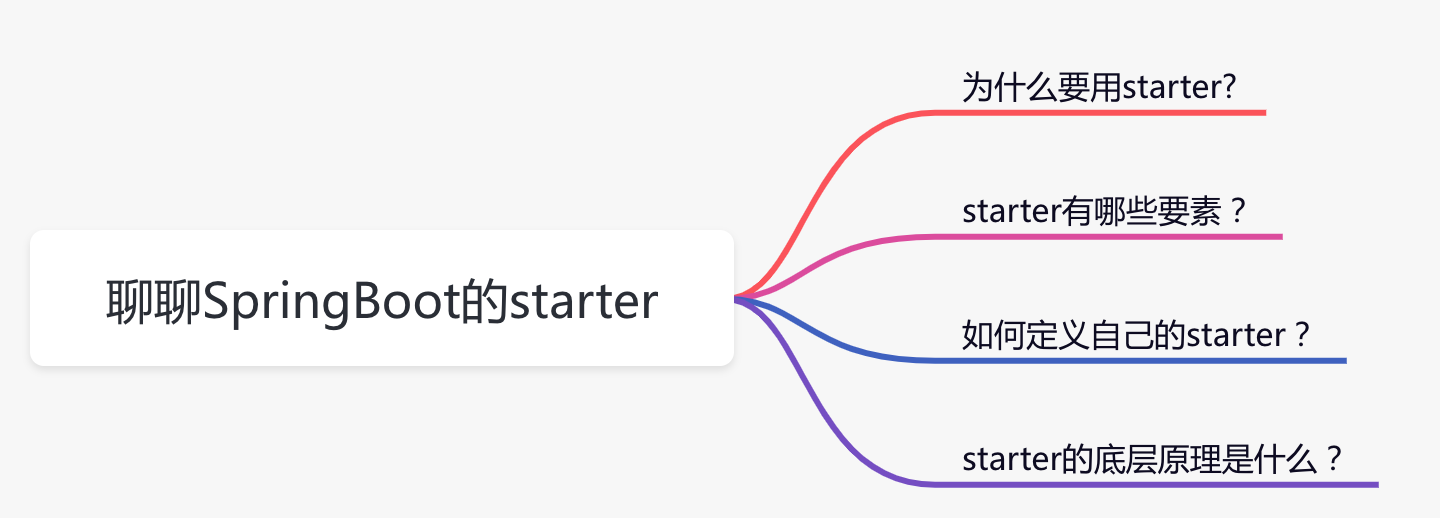
1 为什么要用starter?
在SpringBoot还没有出来之前,我们使用Spring开发项目。如果程序需要连接数据库,我们一般会使用Hibernate或Mybatis等ORM框架,这里我以Mybatis为例,具体的操作步骤如下:
- 到maven仓库去找需要引入的mybatis jar包,选取合适的版本。
- 到maven仓库去找mybatis-spring整合的jar包,选取合适的版本。
- 在spring的applicationContext.xml文件中配置dataSource和mybatis相关信息。
当然有些朋友可能会指正,不是还需要引入数据库驱动包吗?
确实需要引入,但数据库驱动有很多,比如:mysql、oracle、sqlserver,这不属于mybatis的范畴,使用者可以根据项目的实际情况单独引入。
如果程序只是需要连接数据库这一个功能还好,按上面的步骤做基本可以满足需求。但是,连接数据库可能只是庞大的项目体系中一个环节,实际项目中往往更复杂,需要引入更多的功能,比如:连接redis、连接mongodb、使用rocketmq、使用excel功能等等。
引入这些功能的话,需要再把上面的步骤再重复一次,工作量无形当中增加了不少,而且有很多重复的工作。
另外,还是有个问题,每次到要到maven中找合适的版本,如果哪次找的mybatis.jar包 和 mybatis-spring.jar包版本不兼容,程序不是会出现问题?
SpringBoot为了解决以上两个问题引入了starter机制。
2 starter有哪些要素?
我们首先一起看看mybatis-spring-boot-starter.jar是如何定义的。

可以看到它的META-INF目录下只包含了:
- pom.protperties 配置maven所需的项目version、groupId和artifactId。
- pom.xml 配置所依赖的jar包。
- MANIFEST.MF 这个文件描述了该Jar文件的很多信息。
- spring.provides 配置所依赖的artifactId,给IDE使用的,没有其他的作用。
注意一下,没有一行代码。
我们重点看一下pom.xml,因为这个jar包里面除了这个没有啥重要的信息
<?xml version="1.0" encoding="UTF-8"?>
<project xmlns="http://maven.apache.org/POM/4.0.0" xmlns:xsi="http://www.w3.org/2001/XMLSchema-instance" xsi:schemaLocation="http://maven.apache.org/POM/4.0.0 http://maven.apache.org/xsd/maven-4.0.0.xsd">
<modelVersion>4.0.0</modelVersion>
<parent>
<groupId>org.mybatis.spring.boot</groupId>
<artifactId>mybatis-spring-boot</artifactId>
<version>1.3.1</version>
</parent>
<artifactId>mybatis-spring-boot-starter</artifactId>
<name>mybatis-spring-boot-starter</name>
<dependencies>
<dependency>
<groupId>org.springframework.boot</groupId>
<artifactId>spring-boot-starter</artifactId>
</dependency>
<dependency>
<groupId>org.springframework.boot</groupId>
<artifactId>spring-boot-starter-jdbc</artifactId>
</dependency>
<dependency>
<groupId>org.mybatis.spring.boot</groupId>
<artifactId>mybatis-spring-boot-autoconfigure</artifactId>
</dependency>
<dependency>
<groupId>org.mybatis</groupId>
<artifactId>mybatis</artifactId>
</dependency>
<dependency>
<groupId>org.mybatis</groupId>
<artifactId>mybatis-spring</artifactId>
</dependency>
</dependencies>
</project>
从上面可以看出,pom.xml文件中会引入一些jar包,其中除了引入spring-boot-starter,之外重点看一下:mybatis-spring-boot-autoconfigure。
我们找到mybatis-spring-boot-autoconfigure.jar文件,打开这个文件。
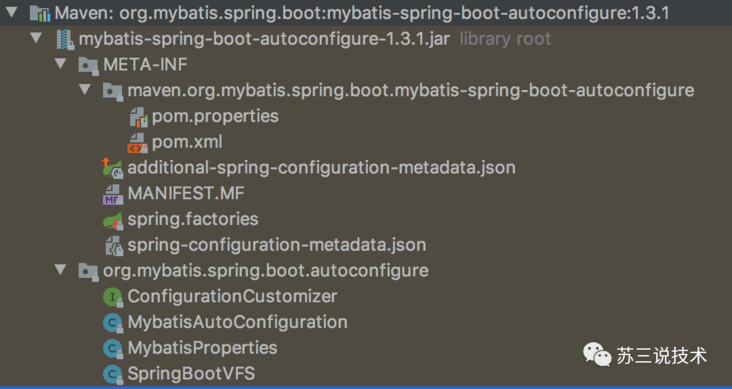
里面包含如下文件:
- pom.properties 配置maven所需的项目version、groupId和artifactId
- pom.xml 配置所依赖的jar包
- additional-spring-configuration-metadata.json 手动添加IDE提示功能
- MANIFEST.MF 这个文件描述了该Jar文件的很多信息
- spring.factories SPI会读取的文件
- spring-configuration-metadata.json 系统自动生成的IDE提示功能
- ConfigurationCustomizer 自定义Configuration回调接口
- MybatisAutoConfiguration mybatis配置类
- MybatisProperties mybatis属性类
- SpringBootVFS 扫描嵌套的jar包中的类
spring-configuration-metadata.json和additional-spring-configuration-metadata.json的功能差不多,我们在applicationContext.properties文件中输入spring时,会自动出现下面的配置信息可供选择,就是这个功能了。
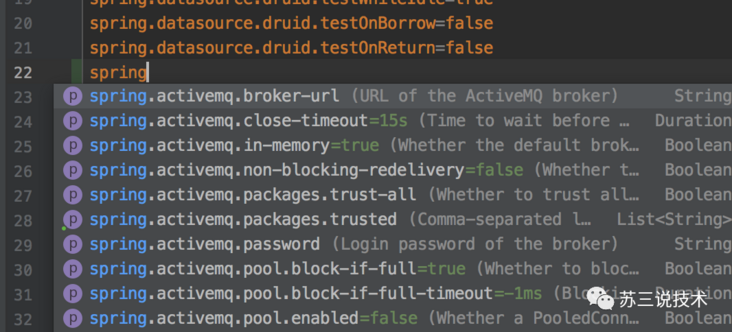
来自灵魂的一问:这两个文件有什么区别?
答:如果pom.xml中引入了spring-boot-configuration-processor包,则会自动生成spring-configuration-metadata.json。
如果需要手动修改里面的元数据,则可以在additional-spring-configuration-metadata.json中编辑,最终两个文件中的元数据会合并到一起。
MybatisProperties类是属性实体类:
@ConfigurationProperties(prefix = MybatisProperties.MYBATIS_PREFIX)
public class MybatisProperties {
public static final String MYBATIS_PREFIX = "mybatis";
private String configLocation;
private String[] mapperLocations;
private String typeAliasesPackage;
private String typeHandlersPackage;
private boolean checkConfigLocation = false;
private ExecutorType executorType;
private Properties configurationProperties;
@NestedConfigurationProperty
private Configuration configuration;
public String getConfigLocation() {
return this.configLocation;
}
public void setConfigLocation(String configLocation) {
this.configLocation = configLocation;
}
@Deprecated
public String getConfig() {
return this.configLocation;
}
@Deprecated
public void setConfig(String config) {
this.configLocation = config;
}
public String[] getMapperLocations() {
return this.mapperLocations;
}
public void setMapperLocations(String[] mapperLocations) {
this.mapperLocations = mapperLocations;
}
public String getTypeHandlersPackage() {
return this.typeHandlersPackage;
}
public void setTypeHandlersPackage(String typeHandlersPackage) {
this.typeHandlersPackage = typeHandlersPackage;
}
public String getTypeAliasesPackage() {
return this.typeAliasesPackage;
}
public void setTypeAliasesPackage(String typeAliasesPackage) {
this.typeAliasesPackage = typeAliasesPackage;
}
public boolean isCheckConfigLocation() {
return this.checkConfigLocation;
}
public void setCheckConfigLocation(boolean checkConfigLocation) {
this.checkConfigLocation = checkConfigLocation;
}
public ExecutorType getExecutorType() {
return this.executorType;
}
public void setExecutorType(ExecutorType executorType) {
this.executorType = executorType;
}
public Properties getConfigurationProperties() {
return configurationProperties;
}
public void setConfigurationProperties(Properties configurationProperties) {
this.configurationProperties = configurationProperties;
}
public Configuration getConfiguration() {
return configuration;
}
public void setConfiguration(Configuration configuration) {
this.configuration = configuration;
}
public Resource[] resolveMapperLocations() {
ResourcePatternResolver resourceResolver = new PathMatchingResourcePatternResolver();
List<Resource> resources = new ArrayList<Resource>();
if (this.mapperLocations != null) {
for (String mapperLocation : this.mapperLocations) {
try {
Resource[] mappers = resourceResolver.getResources(mapperLocation);
resources.addAll(Arrays.asList(mappers));
} catch (IOException e) {
// ignore
}
}
}
return resources.toArray(new Resource[resources.size()]);
}
}
可以看到Mybatis初始化所需要的很多属性都在这里,相当于一个JavaBean。
下面重点看一下MybatisAutoConfiguration的代码:
@org.springframework.context.annotation.Configuration
@ConditionalOnClass({ SqlSessionFactory.class, SqlSessionFactoryBean.class })
@ConditionalOnBean(DataSource.class)
@EnableConfigurationProperties(MybatisProperties.class)
@AutoConfigureAfter(DataSourceAutoConfiguration.class)
public class MybatisAutoConfiguration {
private static final Logger logger = LoggerFactory.getLogger(MybatisAutoConfiguration.class);
private final MybatisProperties properties;
private final Interceptor[] interceptors;
private final ResourceLoader resourceLoader;
private final DatabaseIdProvider databaseIdProvider;
private final List<ConfigurationCustomizer> configurationCustomizers;
public MybatisAutoConfiguration(MybatisProperties properties,
ObjectProvider<Interceptor[]> interceptorsProvider,
ResourceLoader resourceLoader,
ObjectProvider<DatabaseIdProvider> databaseIdProvider,
ObjectProvider<List<ConfigurationCustomizer>> configurationCustomizersProvider) {
this.properties = properties;
this.interceptors = interceptorsProvider.getIfAvailable();
this.resourceLoader = resourceLoader;
this.databaseIdProvider = databaseIdProvider.getIfAvailable();
this.configurationCustomizers = configurationCustomizersProvider.getIfAvailable();
}
@PostConstruct
public void checkConfigFileExists() {
if (this.properties.isCheckConfigLocation() && StringUtils.hasText(this.properties.getConfigLocation())) {
Resource resource = this.resourceLoader.getResource(this.properties.getConfigLocation());
Assert.state(resource.exists(), "Cannot find config location: " + resource
+ " (please add config file or check your Mybatis configuration)");
}
}
@Bean
@ConditionalOnMissingBean
public SqlSessionFactory sqlSessionFactory(DataSource dataSource) throws Exception {
SqlSessionFactoryBean factory = new SqlSessionFactoryBean();
factory.setDataSource(dataSource);
factory.setVfs(SpringBootVFS.class);
if (StringUtils.hasText(this.properties.getConfigLocation())) {
factory.setConfigLocation(this.resourceLoader.getResource(this.properties.getConfigLocation()));
}
Configuration configuration = this.properties.getConfiguration();
if (configuration == null && !StringUtils.hasText(this.properties.getConfigLocation())) {
configuration = new Configuration();
}
if (configuration != null && !CollectionUtils.isEmpty(this.configurationCustomizers)) {
for (ConfigurationCustomizer customizer : this.configurationCustomizers) {
customizer.customize(configuration);
}
}
factory.setConfiguration(configuration);
if (this.properties.getConfigurationProperties() != null) {
factory.setConfigurationProperties(this.properties.getConfigurationProperties());
}
if (!ObjectUtils.isEmpty(this.interceptors)) {
factory.setPlugins(this.interceptors);
}
if (this.databaseIdProvider != null) {
factory.setDatabaseIdProvider(this.databaseIdProvider);
}
if (StringUtils.hasLength(this.properties.getTypeAliasesPackage())) {
factory.setTypeAliasesPackage(this.properties.getTypeAliasesPackage());
}
if (StringUtils.hasLength(this.properties.getTypeHandlersPackage())) {
factory.setTypeHandlersPackage(this.properties.getTypeHandlersPackage());
}
if (!ObjectUtils.isEmpty(this.properties.resolveMapperLocations())) {
factory.setMapperLocations(this.properties.resolveMapperLocations());
}
return factory.getObject();
}
@Bean
@ConditionalOnMissingBean
public SqlSessionTemplate sqlSessionTemplate(SqlSessionFactory sqlSessionFactory) {
ExecutorType executorType = this.properties.getExecutorType();
if (executorType != null) {
return new SqlSessionTemplate(sqlSessionFactory, executorType);
} else {
return new SqlSessionTemplate(sqlSessionFactory);
}
}
public static class AutoConfiguredMapperScannerRegistrar
implements BeanFactoryAware, ImportBeanDefinitionRegistrar, ResourceLoaderAware {
private BeanFactory beanFactory;
private ResourceLoader resourceLoader;
@Override
public void registerBeanDefinitions(AnnotationMetadata importingClassMetadata, BeanDefinitionRegistry registry) {
ClassPathMapperScanner scanner = new ClassPathMapperScanner(registry);
try {
if (this.resourceLoader != null) {
scanner.setResourceLoader(this.resourceLoader);
}
List<String> packages = AutoConfigurationPackages.get(this.beanFactory);
if (logger.isDebugEnabled()) {
for (String pkg : packages) {
logger.debug("Using auto-configuration base package '{}'", pkg);
}
}
scanner.setAnnotationClass(Mapper.class);
scanner.registerFilters();
scanner.doScan(StringUtils.toStringArray(packages));
} catch (IllegalStateException ex) {
logger.debug("Could not determine auto-configuration package, automatic mapper scanning disabled.", ex);
}
}
@Override
public void setBeanFactory(BeanFactory beanFactory) throws BeansException {
this.beanFactory = beanFactory;
}
@Override
public void setResourceLoader(ResourceLoader resourceLoader) {
this.resourceLoader = resourceLoader;
}
}
@org.springframework.context.annotation.Configuration
@Import({ AutoConfiguredMapperScannerRegistrar.class })
@ConditionalOnMissingBean(MapperFactoryBean.class)
public static class MapperScannerRegistrarNotFoundConfiguration {
@PostConstruct
public void afterPropertiesSet() {
logger.debug("No {} found.", MapperFactoryBean.class.getName());
}
}
}
这个类就是一个Configuration(配置类),它里面定义很多bean,其中最重要的就是SqlSessionFactory的bean实例,该实例是Mybatis的核心功能,用它创建SqlSession,对数据库进行CRUD操作。
除此之外,MybatisAutoConfiguration类还包含了:
- @ConditionalOnClass 配置了只有包含SqlSessionFactory.class和SqlSessionFactoryBean.class,该配置类才生效。
- @ConditionalOnBean 配置了只有包含dataSource实例时,该配置类才生效。
- @EnableConfigurationProperties 该注解会自动填充MybatisProperties实例中的属性。
- AutoConfigureAfter 配置了该配置类在DataSourceAutoConfiguration类之后自动配置。
这些注解都是一些辅助功能,决定Configuration是否生效,当然这些注解不是必须的。
接下来,重点看看spring.factories文件有啥内容:
org.springframework.boot.autoconfigure.EnableAutoConfiguration=\
org.mybatis.spring.boot.autoconfigure.MybatisAutoConfiguration
里面只有一行配置,即key为EnableAutoConfiguration,value为MybatisAutoConfiguration。
好了,介绍了这么多东西,现在我们来总结一下,
starter几个要素如下图所示:
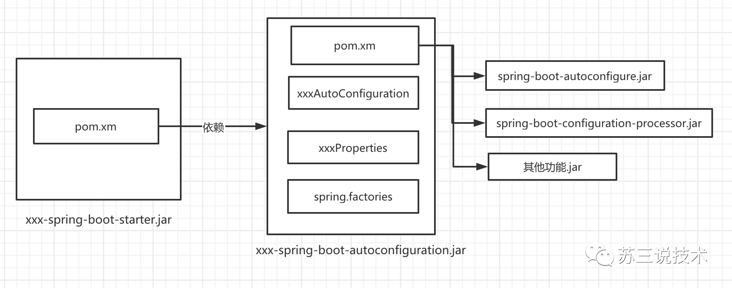
那么,编写starter需要哪些步骤?
- 1.需要定义一个名称为xxx-spring-boot-starter的空项目,里面不包含任何代码,可以有pom.xml和pom.properties文件。
- 2.pom.xml文件中包含了名称为xxx-spring-boot-autoconfigure的项目。
- 3.xxx-spring-boot-autoconfigure项目中包含了名称为xxxAutoConfiguration的类,该类可以定义一些bean实例。当然,Configuration类上可以打一些如:ConditionalOnClass、ConditionalOnBean、EnableConfigurationProperties等注解。
- 4.需要在spring.factories文件中增加key为EnableAutoConfiguration,value为xxxAutoConfiguration。
我们试着按照这四步,自己编写一个starter看看能否成功,验证一下总结的内容是否正确。
3 如何定义自己的starter?
3.1 先创建一个空项目
该项目名称为id-generate-starter,注意为了方便我把项目重命名了,原本应该是叫id-generate-spring-boot-starter的,如下图所示:
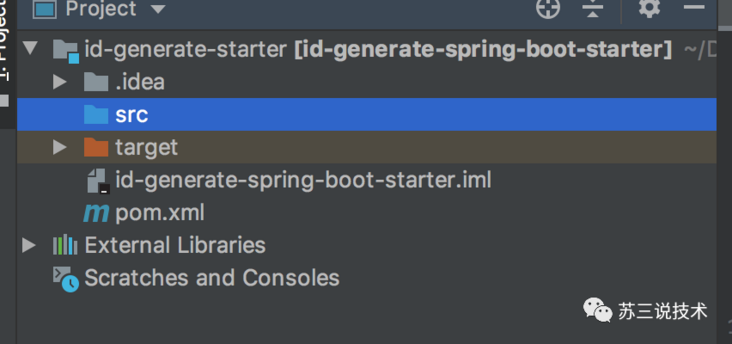
pom.xml文件定义如下:
<?xml version="1.0" encoding="UTF-8"?>
<project xmlns="http://maven.apache.org/POM/4.0.0" xmlns:xsi="http://www.w3.org/2001/XMLSchema-instance" xsi:schemaLocation="http://maven.apache.org/POM/4.0.0 http://maven.apache.org/xsd/maven-4.0.0.xsd">
<modelVersion>4.0.0</modelVersion>
<version>1.3.1</version>
<groupId>com.sue</groupId>
<artifactId>id-generate-spring-boot-starter</artifactId>
<name>id-generate-spring-boot-starter</name>
<dependencies>
<dependency>
<groupId>com.sue</groupId>
<artifactId>id-generate-spring-boot-autoconfigure</artifactId>
<version>1.3.1</version>
</dependency>
</dependencies>
</project>
我们看到,它只引入了id-generate-spring-boot-autoconfigure。当然如果有需要这里还可以引入多个autoconfigure或者多个其他jar包或者。
3.2 创建id-generate-autoconfigure
同样为了方便我把项目重命名了,原本是叫id-generate-spring-boot-autoconfigure,如下图所示:

该项目当中包含:pom.xml、spring.factories、IdGenerateAutoConfiguration、IdGenerateService 和 IdProperties 这5个关键文件,下面我们逐一看看。
先从pom.xml
<?xml version="1.0" encoding="UTF-8"?>
<project xmlns="http://maven.apache.org/POM/4.0.0" xmlns:xsi="http://www.w3.org/2001/XMLSchema-instance" xsi:schemaLocation="http://maven.apache.org/POM/4.0.0 http://maven.apache.org/xsd/maven-4.0.0.xsd">
<parent>
<groupId>org.springframework.boot</groupId>
<artifactId>spring-boot-starter-parent</artifactId>
<version>2.0.4.RELEASE</version>
</parent>
<modelVersion>4.0.0</modelVersion>
<version>1.3.1</version>
<groupId>com.sue</groupId>
<artifactId>id-generate-spring-boot-autoconfigure</artifactId>
<name>id-generate-spring-boot-autoconfigure</name>
<dependencies>
<dependency>
<groupId>org.springframework.boot</groupId>
<artifactId>spring-boot-starter</artifactId>
</dependency>
<dependency>
<groupId>org.springframework.boot</groupId>
<artifactId>spring-boot-autoconfigure</artifactId>
</dependency>
<dependency>
<groupId>org.springframework.boot</groupId>
<artifactId>spring-boot-configuration-processor</artifactId>
<optional>true</optional>
</dependency>
</dependencies>
<build>
<plugins>
<plugin>
<groupId>org.apache.maven.plugins</groupId>
<artifactId>maven-compiler-plugin</artifactId>
<configuration>
<source>1.8</source>
<target>1.8</target>
</configuration>
</plugin>
</plugins>
</build>
</project>
我们可以看到,这个文件比较简单就引入了:
- spring-boot-starter:springboot的相关jar包。
- spring-boot-autoconfigure:springboot自动配置相关jar包。
- spring-boot-configuration-processor:springboot生成IDE提示功能相关jar包。
重点看看spring.factories文件:
org.springframework.boot.autoconfigure.EnableAutoConfiguration=com.sue.IdGenerateAutoConfiguration
它里面只包含一行配置,其中key是EnableAutoConfiguration,value是IdGenerateAutoConfiguration。
再重点看一下IdGenerateAutoConfiguration
@ConditionalOnClass(IdProperties.class)
@EnableConfigurationProperties(IdProperties.class)
@Configuration
public class IdGenerateAutoConfiguration {
@Autowired
private IdProperties properties;
@Bean
public IdGenerateService idGenerateService() {
return new IdGenerateService(properties.getWorkId());
}
}
该类是一个使用了@Configuration注解标记为了配置类,生效的条件是@ConditionalOnClass注解中检测到包含IdProperties.class。并且使用@EnableConfigurationProperties注解会自动注入IdProperties的实例。
此外,最关键的点是该类里面创建了idGenerateService的bean实例,这是自动配置的精髓。
再看看IdGenerateService
public class IdGenerateService {
private Long workId;
public IdGenerateService(Long workId) {
this.workId = workId;
}
public Long generate() {
return new Random().nextInt(100) + this.workId;
}
}
我们可以看到它是一个普通的类,甚至都没有使用@Service注解,里面有个generate方法,根据workId的值和随机数动态生成id。
最后看看IdProperties
@ConfigurationProperties(prefix = IdProperties.PREFIX)
public class IdProperties {
public static final String PREFIX = "sue";
private Long workId;
public Long getWorkId() {
return workId;
}
public void setWorkId(Long workId) {
this.workId = workId;
}
}
它是一个配置实体类,里面包含了相关的配置文件。使用@ConfigurationProperties注解,会自动把application.properties文件中以sue开通的,参数名称跟IdProperties中一样的参数值,自动注入到IdProperties对象中。
3.3 创建id-generate-test
这个项目主要用于测试。
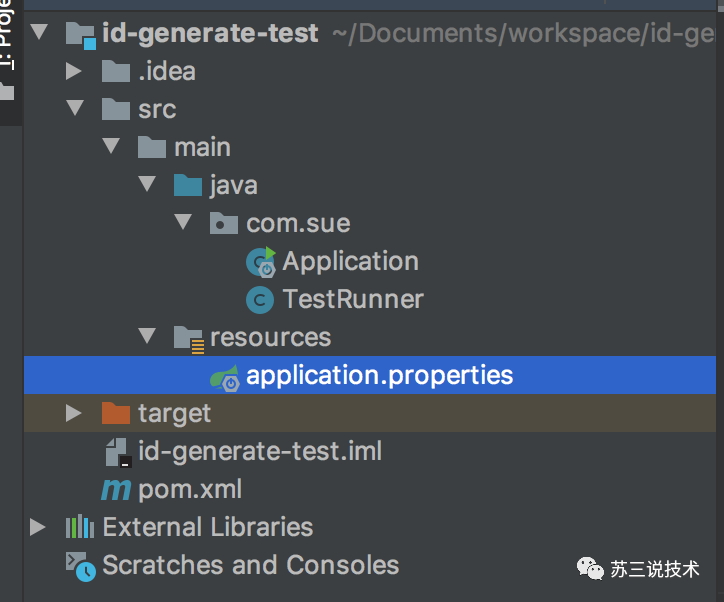
该项目里面包含:pom.xml、application.properties、Application 和 TestRunner 文件。
先看看pom.xml文件
<?xml version="1.0" encoding="UTF-8"?>
<project xmlns="http://maven.apache.org/POM/4.0.0" xmlns:xsi="http://www.w3.org/2001/XMLSchema-instance" xsi:schemaLocation="http://maven.apache.org/POM/4.0.0 http://maven.apache.org/xsd/maven-4.0.0.xsd">
<modelVersion>4.0.0</modelVersion>
<version>1.3.1</version>
<groupId>com.sue</groupId>
<artifactId>spring-boot-id-generate-test</artifactId>
<name>spring-boot-id-generate-test</name>
<dependencies>
<dependency>
<groupId>com.sue</groupId>
<artifactId>id-generate-spring-boot-starter</artifactId>
<version>1.3.1</version>
</dependency>
</dependencies>
</project>
由于只测试刚刚定义的id生成功能,所以只引入的id-generate-spring-boot-starter jar包。
application.properties配置资源文件
sue.workId=123
只有一行配置,因为我们的IdProperties中目前只需要这一个参数。
Application是测试程序启动类
@SpringBootApplication
public class Application {
public static void main(String[] args) {
SpringApplication.run(Application.class, args);
}
}
很简单,就是一个普通的springboot启动类
TestRunner是我们的测试类
@Component
public class TestRunner implements ApplicationRunner {
@Autowired
private IdGenerateService idGenerateService;
public void run(ApplicationArguments args) throws Exception {
Long sysNo = idGenerateService.generate();
System.out.println(sysNo);
}
}
它实现了ApplicationRunner接口,所以在springboot启动的时候会调用该类的run方法。
好了,所有自定义starter的代码和测试代码都已经就绪。接下,运行一下Application类的main方法。
运行结果:
176
完美,验证成功了。
接下来,我们分析一下starter的底层实现原理。
4 starter的底层原理是什么?
通过上面编写自己的starter的例子,相信大家对starter的认识更进一步了,现在跟大家一起看看starter的底层是如何实现的。
id-generate-starter.jar其实是一个空项目,依赖于id-generate-autoconfiguration.jar。
id-generate-starter.jar是一个入口,我们给他取一个更优雅的名字:门面模式,其他业务系统想引入相应的功能,必须要通过这个门面。
我们重点分析一下 id-generate-autoconfiguration.jar
该jar包核心内容是:IdGenerateConfiguration,这个配置类中创建了IdGenerateService对象,IdGenerateService是我们所需要自动配置的具体功能。
接下来一个最重要的问题:
IdGenerateConfiguration为什么会自动加载的呢?
还记得我们定义的spring.factories文件不?
org.springframework.boot.autoconfigure.EnableAutoConfiguration=com.sue.IdGenerateAutoConfiguration
它里面只包含一行配置,其中key是EnableAutoConfiguration,value是IdGenerateAutoConfiguration。
要搞明白这个过程,要从Application类的@SpringBootApplication注解开始:
@Target(ElementType.TYPE)
@Retention(RetentionPolicy.RUNTIME)
@Documented
@Inherited
@SpringBootConfiguration
@EnableAutoConfiguration
@ComponentScan(excludeFilters = {
@Filter(type = FilterType.CUSTOM, classes = TypeExcludeFilter.class),
@Filter(type = FilterType.CUSTOM, classes = AutoConfigurationExcludeFilter.class) })
public @interface SpringBootApplication {
@AliasFor(annotation = EnableAutoConfiguration.class)
Class<?>[] exclude() default {};
@AliasFor(annotation = EnableAutoConfiguration.class)
String[] excludeName() default {};
@AliasFor(annotation = ComponentScan.class, attribute = "basePackages")
String[] scanBasePackages() default {};
@AliasFor(annotation = ComponentScan.class, attribute = "basePackageClasses")
Class<?>[] scanBasePackageClasses() default {};
}
从上面可以看出该注解里面包含了@EnableAutoConfiguration注解。
@Target(ElementType.TYPE)
@Retention(RetentionPolicy.RUNTIME)
@Documented
@Inherited
@AutoConfigurationPackage
@Import(AutoConfigurationImportSelector.class)
public @interface EnableAutoConfiguration {
String ENABLED_OVERRIDE_PROPERTY = "spring.boot.enableautoconfiguration";
Class<?>[] exclude() default {};
String[] excludeName() default {};
}
@EnableAutoConfiguration注解会引入AutoConfigurationImportSelector类。
该类的selectImports方法一个关键方法:
@Override
public String[] selectImports(AnnotationMetadata annotationMetadata) {
//配置有没有配置spring.boot.enableautoconfiguration开关,默认为true
//如果为false,则不执行自动配置的功能,直接返回
if (!isEnabled(annotationMetadata)) {
return NO_IMPORTS;
}
//找spring-autoconfigure-metadata.properties中的元素
AutoConfigurationMetadata autoConfigurationMetadata = AutoConfigurationMetadataLoader
.loadMetadata(this.beanClassLoader);
//获取EnableAutoConfiguration注解中的属性
AnnotationAttributes attributes = getAttributes(annotationMetadata);
//获取工程下所有配置key为EnableAutoConfiguration的值,即IdGenerateConfiguration等类。
List<String> configurations = getCandidateConfigurations(annotationMetadata,
attributes);
//删除重复的值
configurations = removeDuplicates(configurations);
//获取需要排除的规则列表
Set<String> exclusions = getExclusions(annotationMetadata, attributes);
//检查
checkExcludedClasses(configurations, exclusions);
//删除需要排除的值
configurations.removeAll(exclusions);
//根据配置文件中配置的开关,过滤一部分不满足条件的值
configurations = filter(configurations, autoConfigurationMetadata);
fireAutoConfigurationImportEvents(configurations, exclusions);
return StringUtils.toStringArray(configurations);
}
这里就是starter能够自动配置的秘密。
此外,有些朋友看其他人定义的springboot starter可能会有疑惑。
先看看druid-spring-boot-starter
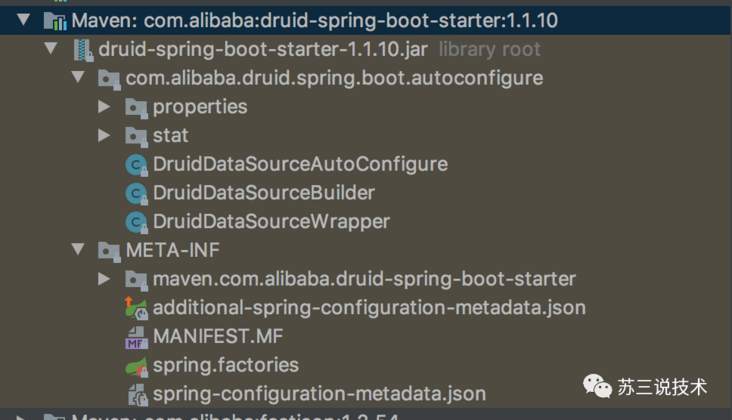
alibaba定义的druid-spring-boot-starter只有xxx-spring-boot-starter.jar文件,而没有xxx-spring-boot-autoconfigure.jar文件。
再看看spring-boot-starter-jdbc:

更神奇的是这个文件中连pom.xml都没有,一脸懵逼。。。。。。。
是不是我讲错了?
答:其实没有。
SpringBoot的原则是约定优于配置。
从spring-boot-starter-jdbc内部空实现来看,它的约定是要把xxx-spring-boot-starter.jar和xxx-spring-boot-autoconfigure.jar区分开的。个人认为,alibaba定义得并不好,没有遵照springboot的约定,虽然功能不受影响。(这个地方欢迎一起探讨一下)
而springboot自己定义的spring-boot-starter-jdbc为什么连pom.xml文件也没有呢?
它不需要依赖xxx-spring-boot-autoconfigure.jar文件吗?
因为springboot把所有的自动配置的类都统一放到spring-boot-autoconfigure.jar下面了:
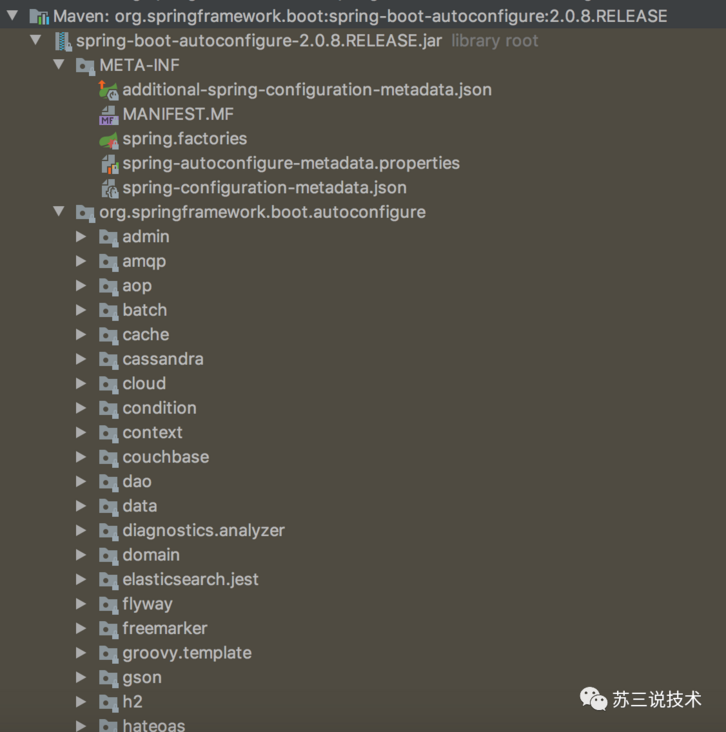
spring.factories文件内容如下:
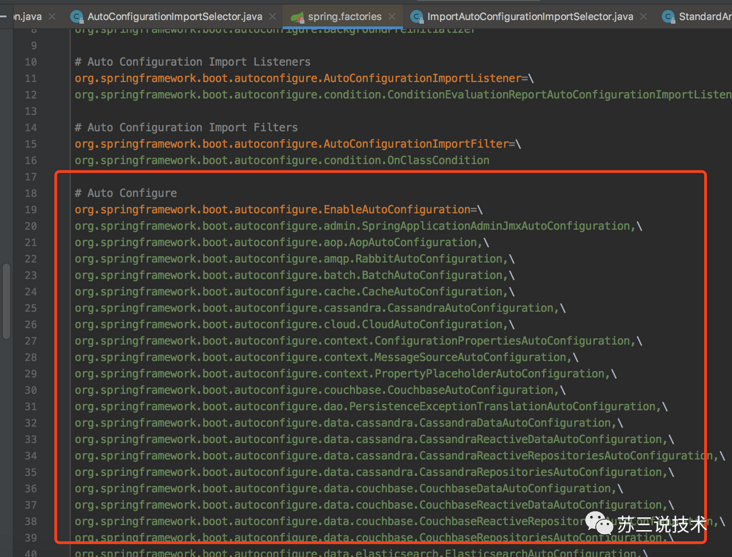
SpringBoot这样集中管理自动配置,而不需要从各个子包中遍历,我个人认为是为了查找效率。
我们最后再看看spring-cloud-starter-openfegin

明显看到,它是遵循了我们说的原则的。
除此之外,还有一个原则一顺便提一下。
SpringBoot和SpringCloud系列定义jar包的名称是:
- spring-boot-starter-xxx.jar
- spring-cloud-starter-xxx.jar
而我们自己的项目定义的jar应该是:
- xxx-spring-boot-starter.jar
最后说一句(求关注,别白嫖我)
如果这篇文章对您有所帮助,或者有所启发的话,帮忙扫描下发二维码关注一下,您的支持是我坚持写作最大的动力。
求一键三连:点赞、转发、在看。
关注公众号:【苏三说技术】,在公众号中回复:面试、代码神器、开发手册、时间管理有超赞的粉丝福利,另外回复:加群,可以跟很多BAT大厂的前辈交流和学习。
SpringBoot的starter到底是什么?的更多相关文章
- SpringBoot常用Starter介绍和整合模板引擎Freemaker、thymeleaf 4节课
1.SpringBoot Starter讲解 简介:介绍什么是SpringBoot Starter和主要作用 1.官网地址:https://docs.spring.io/spring-boot/doc ...
- 如何封装springboot的starter
--为啥要封装starter --如何封装 --测试 为啥要封装starter springboot的starter开箱即用,只需要引入依赖,就可以帮你自动装配bean,这样可以让开发者不需要过多的关 ...
- 手撸一个SpringBoot的Starter,简单易上手
前言:今天介绍一SpringBoot的Starter,并手写一个自己的Starter,在SpringBoot项目中,有各种的Starter提供给开发者使用,Starter则提供各种API,这样使开发S ...
- SpringBoot --- 自定义 Starter
SpringBoot --- 自定义 Starter 创建 1.需要创建一个新的空工程 2.新的工程需要引入两个模块 一个Maven 模块 作为启动器 一个SpringBoot 模块 作为自动配置模块 ...
- SpringBoot自定义starter开发分布式任务调度实践
概述 需求 在前面的博客<Java定时器演进过程和生产级分布式任务调度ElasticJob代码实战>中,我们已经熟悉ElasticJob分布式任务的应用,其核心实现为elasticjob- ...
- SpringBoot系列三:SpringBoot自定义Starter
在前面两章 SpringBoot入门 .SpringBoot自动配置原理 的学习后,我们对如何创建一个 SpringBoot 项目.SpringBoot 的运行原理以及自动配置等都有了一定的了解.如果 ...
- springboot自定义starter
1,创建一个空工程 2,new一个Modules ---------------- maven (启动器) : springboottest-spring-boot-starter 3,new一个M ...
- SpringBoot自动化配置之四:SpringBoot 之Starter(自动配置)、Command-line runners
Spring Boot Starter是在SpringBoot组件中被提出来的一种概念,stackoverflow上面已经有人概括了这个starter是什么东西,想看完整的回答戳这里 Starter ...
- SpringBoot自定义starter及自动配置
SpringBoot的核心就是自动配置,而支持自动配置的是一个个starter项目.除了官方已有的starter,用户自己也可以根据规则自定义自己的starter项目. 自定义starter条件 自动 ...
随机推荐
- Windows快捷安装应用方法(此处以Virtualbox为例)
1.执行已下载的virtualbox的安装exe文件,使用pywinauto模拟点击Windows安装的对应控件 1.1.启动exe文件 start *.exe 1.2.使用pywinauto(也适用 ...
- Vue 模板语法 && 数据绑定
1 <!DOCTYPE html> 2 <html> 3 <head> 4 <meta charset="UTF-8" /> 5 & ...
- 抖音 滑块验证方案 s_v_web_id 参数分析
本文所有教程及源码.软件仅为技术研究.不涉及计算机信息系统功能的删除.修改.增加.干扰,更不会影响计算机信息系统的正常运行.不得将代码用于非法用途,如侵立删! 抖音web端 s_v_web_id 参数 ...
- Floyd算法详解
Floyd本质上使用了DP思想,我们定义\(d[k][x][y]\)为允许经过前k个节点时,节点x与节点y之间的最短路径长度,显然初始值应该为\(d[k][x][y] = +\infin (k, x, ...
- MyBatis 02 配置
导入jar包 <dependency> <groupId>org.mybatis</groupId> <artifactId>mybatis</a ...
- [网鼎杯2018]Unfinish-1|SQL注入|二次注入
1.进入题目之后只有一个登录界面,检查源代码信息并没有发现有用的信息,尝试万能密码登录也不行,结果如下: 2.进行目录扫描,发现了注册界面:register.php,结果如下: 3.那就访问注册界面, ...
- Vue刷新页面VueX中数据清空了,怎么重新获取?
Vue刷新页面VueX数据清空了,怎么重新获取? 点击打开视频讲解更详细 在vue中刷新页面后,vuex中的数据就没有了,这时我们要想使用就要重新获取数据了, 怎么在刷新后重新获取数据呢??? 这时我 ...
- 如何在 Windows 和 Linux 上确定系统使用的是 MBR 分区还是 GPT 分区详细步骤!!!
在 Windows 上检查系统使用的是 MBR 分区还是 GPT 分区 点击放大镜搜索输入disk 点击打开 进入之后,右键点击你想要检查分区方案的磁盘,在右键菜单里选择属性! 在属性窗口,切换到卷, ...
- PHP生成唯一不重复的编号
当我们要将一个庞大的数据进行编号时,而编号有位数限制,比如5位的车牌号.10位的某证件号码.订单流水号.短网址等等,我们可以使用36进制计算出符合位数的不重复的编号. 下载:https://url72 ...
- KingbaseES 两表关联Update的两种写法与性能
熟悉oracle 的人都知道,对于两表的关联更新,其执行计划主要有 Filter 和 Outer Join 两种方式.对于大批量数据的update,Join方式明显是更优的选择.KingbaseES ...
